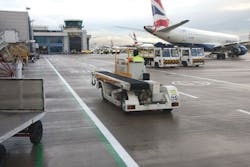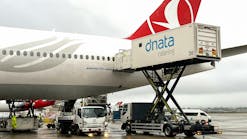A Brief History Of Line Operations Safety Audits
Tax season is upon us and for some folks and organizations the word “audit” inherently has a negative connotation attached to it.
In the aviation industry, the term has a better meaning. Line Operations Safety Audits or LOSA is a safety management program that is available to help identify risks within airlines operations. Human Factors is a big part of the LOSA program, specifically, principals for Threat and Error Management or TEM.
Over the last 23 years, LOSA has developed from a program that was initially constructed for analysis of behaviors in the flight deck into an operational strategy for real-time data analysis of normal operations that supports data-driven organizational change based on employee threat and error management at the maintenance and ramp operations level.
The original research development of the maintenance and ramp LOSA forms and procedures was under the direction of the former Air Transport Association or ATA, which is now known as Airlines 4 America or A4A). The organization’s Human Factors Task Force with funding primarily supported through the FAA. The task force consulted numerous airline safety representatives who participated in the development and implementation of the current maintenance and ramp line operations safety auditing efforts.
LOSA BASICS
LOSA is comprised of several characteristics that include peer-to-peer observations during normal operations by trusted and trained observers using observation techniques based on TEM.
Joint management/union sponsorship will need to be coordinated to ensure success. The data collection process is non-punitive; observations will be anonymous and confidential with observational data being housed in a secure data collection warehouse.
Once data has been collected, organizations will need to verify the data with the LOSA team and operational leadership which should result in data-derived targets for improvement. Most importantly, feedback from the LOSA observations will need to be communicated back out to the workforce.
The purpose of a Safety Management System is to provide a systematic way to control risk and to provide assurance that those risk controls are effective. An SMS will also identify risk and ensure that it is designed out or reduced to an acceptable level for new programs before implementation.
Air carriers and airports across the United States have been addressing the FAA’s proposed 14 CFR Part 5. The SMS NPRM also includes the draft revision to AC 120-92 and the new draft SMS chapter for FAA Order 8900.1. The FAA’s proposed SMS rule and guidance materials are modeled after the ICAO’s SMS Framework.
Safety risk management (SRM) requires development of processes and procedures to provide an understanding of the carrier’s operational systems to allow operational employees identify hazards associated with those systems. Once hazards are identified, other procedures must be developed under SRM to analyze and assess the risk resulting from these hazards, as well as to institute controls to reduce or eliminate the risks from these hazards.
Most safety programs are developed to be used as a response mechanism to events (incidents and accidents) that have already occurred in the operation. LOSA can help actively identify hazards through the analysis of the organizations processes. A healthy LOSA program will also assist with proactive analysis that closely looks at system processes and environment to identify any potential problems that may occur in the future.
Ground and maintenance LOSA programs have evolved from early Crew Resource Management (CRM) principals that were used during flight deck LOSA development to analysis that focused on human error and Threat and Error Management, which is the currently the main principal behind ground LOSA programs.
One of the main objectives behind line operations safety audits is to identify employee behaviors that lead to effective and ineffective threat and error management. Many “red flags” or “threats” that occur in the operation at any given time most often times do not lead to an accident or incident; LOSA helps organizations understand employee response to these “red flags” or “threats” that have not led to negative consequences such as aircraft damage or employee injuries.
TEM understands that threats, such as unfavorable weather, errors, such as speeding on the ramp, while driving GSE, and undesired states, such as a late arriving aircraft, are everyday events that employees working in an airport environment must manage to maintain the safety of equipment, other employees and themselves.
RISK FACTORS
If we take a look into risk factors that are present in the everyday airport operating environments, threats are considered normal or abnormal, which could lead an employee into a situation that can cause an employee to commit a potential error or result in a bad outcome.
Error management takes actions against those errors that have been committed by identifying them and putting a corrective action plan in place to eliminate them, or containing the errors and reducing the severity of the error outcome. Error management is often considered managing the past where is threat management is considered managing the future.
Errors occur when a mistake has been mismanaged; managing errors requires recognition and correction before these errors have a negative consequence to safety.
Some types of errors are intentional, non-compliance errors, but also procedural errors, and errors that occur during miscommunication. Proficiency errors and operational decision errors can be inconsequential to safety, but can also lead to an undesirable state if it is not addressed correctly or ignored. This may also lead to additional errors and may make situations worse.
LOSA is a tool that can be used in the operation to help identify threats, errors and undesired states and can assist in building strategies and mitigation plans to reduce risks in the airport environment. LOSA helps front line employees become better threat managers by actively identifying threats in the operation and helps build a safety culture by encouraging open and honest communications.
About the author: Kevin P. Crowley, senior analyst for ground safety programs, CQA/ASQ, JetBlue Airways Corp., started on the ramp in Buffalo, NY, in 1993. He's been with JetBlue for 12 years and began as an instructor at JetBlue University and taught aircraft servicing for the A320 and E190. He has additional experience in HAZMAT and dangerous goods; winter ops and deicing; and is a certified OHSA instructor.





